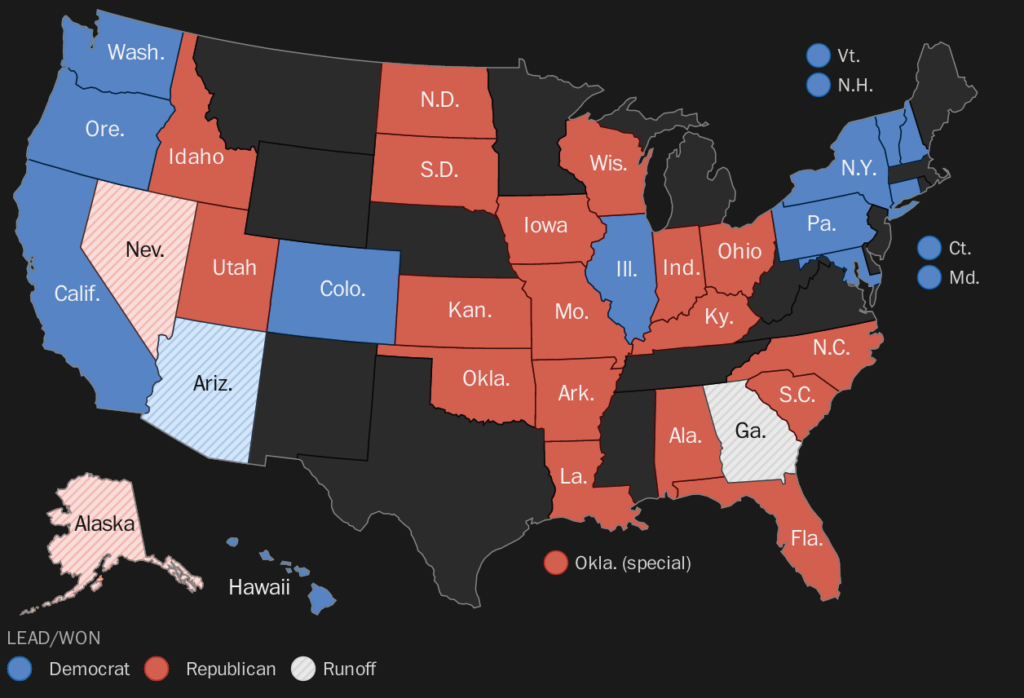It wasn’t a “red wave,” more like, as conservative writer Mona Charen put it, “a small toxic spill” where “voters of Pennsylvania, Virginia, New Hampshire, and Michigan, among other places, apparently weighed more than inflation in their calculations, and that gives a fighting chance to those who hope to right this listing ship.”
Democrats have little to crow about, particularly in some of the reddest of the red states – Idaho, Montana, South Dakota among others, but they didn’t get swamped nationally, which typically happens to the party in the White House in a midterm election.

Many, but certainly not all, election deniers lost, ensuring that the “big lie” will continue to float at the top of our national political septic tank. Idaho, to cite just one example, hasn’t yet copped, but soon enough will, to having elected a professional agitator (and election denier) as attorney general, a political opportunist who will cause a wholesale exodus from the state’s largest law firm. You heard it here: Raul Labrador, a Tea Partier who left a lot of wreckage in his wake while in Congress, wanted a new job in order to play politics with the law and then use that ruse to run for governor.
Montana voters looked past the scandals and carpetbagging of Ryan Zinke, their former congressman and our ethically challenged former Interior Secretary, to send Zinke back to Congress. He’ll fill a seat once occupied by the likes of Jeannette Rankin, Mike Mansfield, Lee Metcalf and Pat Williams. This is politically trading down on an epic scale, rather like swapping your new Bentley for a rusted out Edsel you can’t get started.
My old South Dakota stomping ground once had a Democratic Party. It doesn’t anymore. There a very Trumpy, made for TV governor, Kristi Noem, used her position of public trust to pressure a state agency to provide preferential treatment for her daughter, and spent most of her term flying around the country to raise her national profile. Noem won with 62% of the vote, proving that many – maybe most – red state conservatives are willing to tolerate a little garden variety corruption as long as their side wins.
There will more than enough time – too much time – for the extended postmortems and the already endless speculation about 2024, but this much seems fairly clear.
The ol’ US of A is profoundly divided, a country riven by one side’s willingness to embrace grievance, demonstrable lies and entertain authoritarianism, while the other side thrashes about to barely compete in a majority of states, often failing to supply a compelling narrative about the economy or the future.
Democrats in places like Idaho and South Dakota must make a choice. Continue the old practice of working from the top down, failing miserably in doing so – the Idaho gubernatorial candidate had the worst Democratic showing since Calvin Coolidge was in the White House – or embrace a bottom up strategy that begins with an all-out appeal to younger voters, many of whom haven’t been alive long enough to see how a two party system once worked.
The party must go both extremely local and determinedly old school, with a relentless focus on engaging voters where they are. It won’t be quick or immediately satisfying, but doing the same old thing isn’t either.
Where abortion was an issue, Democrats – again with the help of younger voters – prevailed. Pro-choice provisions succeeded in nominally Democratic Michigan and solidly Republican Kentucky.

As University of Montana political scientist Rob Saldin and I observed immediately after May’s stunning Supreme Court decision overturning abortion protections, Idaho’s 1990 experience with the issue offers a big tell. That election, Cecil Andrus’s fourth term, marks the modern high water mark for Idaho Democrats, in no small part because the then-governor framed the anti-choice issue as one of vast Republican overreach.
“If the issue is framed correctly,” Saldin and I wrote for the Washington Post, “the sense of grievance surrounding abortion that has long propelled the right will shift, energizing voters looking to preserve access to abortion and catalyzing their support.” And it is happening.
One outcome of this wild midterm election would have passed without comment before 2020 – there was no rigged outcome. Elections from Pennsylvania to Arizona were run professionally and fairly. To believe otherwise is to live in a Trumpian la la land where a rigged election is the only way to explain why a twice impeached failed real estate developer who only won against the weakest Democratic candidate since Michael Dukakis, lost in 2020.
Both parties are due a reckoning, as should happen after every election. Democrats need to commit to a kitchen table agenda and the kind of blunt language Harry Truman used so effectively. The party needs to compete aggressively in rural America, just as it does on the left coast. Democrats need more of Jon Tester, the blue collar farmer from Montana, and more like new senator John Fetterman of Pennsylvania, a tattooed exponent of no nonsense politics who beat a slick, quack TV doctor like a drum, and Fetterman won after suffering a stroke during the campaign.
The Republican reckoning will be vastly more unpleasant, as well as more important to the future of the country. Republicans seem sure to have a wafer-thin margin in the House of Representatives and the most radical right wingers in the party seem determined to display immediately why they shouldn’t be anywhere near political power. The crazy caucus already has the knives out for would-be speaker Kevin McCarthy, and like John Boehner and Paul Ryan before him McCarthy will likely be no match for fellow Republicans wielding pitchforks.
And Republicans will eventually have to deal – or not – with the insurrectionist wing of their party, a genuine problem in Idaho where militia leader Ammon Bundy pulled 17 percent of the vote.
And, of course, there is the ghost of Mar a Lago. What to do with the cancer growing on the Grand Old Party, what the Wall Street Journal – yes, that Wall Street Journal – termed “the Republican Party’s biggest loser?”
Sane and sober Republicans surely know Donald Trump would gladly burn the party to the ground if it served his malicious purposes. Better get the fire extinguishers ready.
The recent election wasn’t a diabolic mess for democracy, thank the lord, but rather a choice for more of the same. The party that does some soul-searching and recalibrating to find a new and better path forward for the country is the party to favor the next time we whip ourselves into a frenzy over an election.
—–0—–
Additional Reading:
You may find something here of interest …
“Don’t Join the Book Burners”
In June of 1953, President Dwight Eisenhower delivered the commencement speech at Dartmouth College in New Hampshire. That old speech is strangely relevant again. This piece from a student who was there.
“I was not thinking of Sen. Joseph McCarthy as I watched Eisenhower rise to deliver what were expected to be his brief remarks. But Eisenhower decided to add something more substantive.
“‘Don’t join the book burners,” Ike said.'”
Is this the end of Britishness?
Ian Jack was a terrific British journalist and editor. Jack died recently and a lot of folks in the Mother Country are remembering his enormous body of work, including this piece written at the time Scotland was considering independence.

The writing is superb. The history lesson valuable. The storytelling marvelous.
“Is it, as VS Naipaul once remarked of British culture, all over?
“During the past dozen years, the Scottish National party has worked an astonishing transformation, turning the tables so that unionism now looks sentimental – the home of exhausted tradition – while independence stands for energetic progress. Over that time, the death of Britishness has been predicted as often as the death of the novel, but it has managed to survive and even to grow.”
When bipartisanship really happened
I wrote a piece recently for a wonderful online publication – The Daily Montanan.
For the essay, I drew on the research I’ve done for a new book – coming in 2023. The book is the story of the political and personal relationship between Senate majority leader Mike Mansfield of Montana and minority leader Everett Dirksen of Illinois.

The two men worked together, in a beautiful bipartisan way, to pass civil rights and voting rights legislation, create Medicare and ratify the first major nuclear arms control treaty, and they supported the president during a tense showdown over missiles in Cuba.
“When President John Kennedy had to confront the Kremlin’s nuclear threat in 1962, he enjoyed, indeed solicited, bipartisan congressional support for his strategy, even to the point of insisting that the Republican leader of the United States Senate suspend his re-election campaign in order to participate in urgent consultations at the White House. In our times of fractured partisanship when Republican and Democratic congressional leaders seem barely able to talk to one another let alone offer words of encouragement and support while reasoning through a crisis together with a president, the domestic political lessons of that long ago nuclear showdown bear remembering – and emulating.”
The book was great fun to work on. Here’s a sneak preview.
For those who are thinking democracy dodged a bullet this week – you’re right. There is much work to do. Be about it, friends. All the best.
